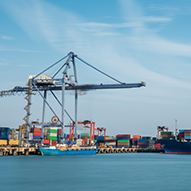Digitalisation: SME’s secret weapon against global trade uncertainties
Current events are changing the way global trade is undertaken. Geopolitical tensions[1] and transport restrictions arising from the Covid-19 pandemic have led to supply chain disruptions,[2] with companies facing a shortage of critical manufacturing components and other associated issues.

The trade finance gap now stands at US$1.7 trillion, disproportionately impacting small and medium-sized enterprises (SMEs).[3]
This volatile and uncertain business landscape has compelled many SMEs to embrace technological solutions or digital transformation. In Singapore, 70 percent of large corporates and middle-market companies were implementing digital transformation strategies as of 2021. The pandemic accelerated adoption, with more SMEs shedding paper-based transactions in favour of digital processes, as they realised how digital trade finance solutions can help ensure operational efficiency and business continuity plan.
Trade finance digitalisation can play a significant role in helping SMEs build long-term resilience, particularly for those engaged in cross-border trade. SMEs can use digitalisation to conduct business more effectively amidst global trade disruptions, strengthen supply chain links, and improve access to trade finance solutions.
What is digitalisation of trade?
While there is no universal definition of trade digitalisation, it typically involves the digital twinning of supply chains, dematerialisation of documents and digital data exchange: at the most basic level, adding an electronic or computerised layer to business processes.
But digitalisation is also about using digital channels to help SMEs create value, which is a crucial distinction in the new normal. By eliminating the reliance on paper-based transactions, SMEs can gain greater productivity and transparency, and preventing delays due to physical documents getting lost or destroyed along the way.
Increased business efficiency and competitiveness
One of the areas that SMEs can increase their business efficiency is through their interactions with banking partners. For instance, instead of submitting paper-based applications for banking services and making visits to physical branches, SMEs can leverage on their banks’ internet banking platforms to digitally submit their applications, saving both time and cost.
DBS offers SMEs a convenient and fuss-free way to apply for letters of credit, banker’s guarantees, shipping guarantee and/or trade loans via DBS IDEAL. Real-time tracking of application status is available over IDEAL, as well as a library of useful reports that can help SMEs stay on top of their day-to-day transactions and easily manage their cashflow and working capital needs. SMEs can even provide suppliers with access to DBS’s financing through the latter’s Supplier Payment Services (SPS), with DBS IDEAL enabling quick and scalable onboarding of participating suppliers.
By incorporating digital solutions into their business processes, SMEs can also obtain valuable data offering them insights into their business performance, and intelligent advisory for decision-making. For instance, the implementation of a cloud-based inventory management system can help SMEs efficiently manage inventory through real-time visibility and forecasting analytics. By analysing data to identify trends and adapt to dynamic market conditions, business managers can order the right amount of product to fulfill customer orders, without wasting resources on unnecessary inventory, or being caught off guard by unexpectedly high demand.
Greater access to trade financing
By providing SMEs with greater transparency and visibility into their supply chain, digitalisation can increase the access to trade financing for SMEs. For instance, SMEs can share transactional information directly from their accounting systems with partner banks, which helps facilitate the bank’s credit assessment of the SME and enables them to provide a tailored working capital solution for their business.
Over the past year, DBS has brought new partners on board to help increase SMEs’ access to trade financing. Xero, the global small business accounting platform, and DBS announced a partnership in May 2022 to simplify the loan application process and increase access to working capital for SMEs in Singapore and Hong Kong.
Another example is SGTraDex (Singapore Trade Data Exchange), a digital infrastructure which facilitates trusted and secure sharing of data between industry players. Recently, DBS completed its first live transaction on SGTraDex to digitalise trade workflows with leading bunker player Kenoil Marine Service. Through a digital bunker delivery note (BDN), parties involved in the transaction were able to ascertain the trade data at source, validating transaction details in near real-time. The higher levels of trust and transparency generated by digitalised trade workflows can help to increase lending appetite of banks towards SMEs in the long run.
SMEs can also benefit from banks’ increasing willingness to lend based on alternative sources of data. Instead of assessing a potential borrower’s creditworthiness based on traditional sources such as their annual financial report, new credit decision models based on big data and analytics can be used to help banks to increase their financing to SMEs. For example, Through a partnership with JD Logistics (JDL), DBS is able to leverage real-time supply chain transaction data, such as inventory and sales proceeds collected from the end consumer to provide supply chain financing to JDL’s e-commerce SMEs.
Broader ecosystem support for digitalisation
Leading players in the trade industry are already mobilising towards digital trade and electronic documentation.[4] As the trade economy evolves, so should the businesses that want to thrive in it.
Contrary to what most business owners might believe, digital solutions are much more accessible for SMEs today. With a view to building the world’s leading digital economy, the Singapore government has signed digital economy agreements (DEAs) with Australia, Chile, New Zealand, South Korea and the United Kingdom, which establish rules and standards that make it easier for SMEs to digitally trade with partners in these countries.[5] These DEAs also enable more affordable trade through the adoption of paperless trading, electronic contracts, and other digital systems.[6]
In the Singapore Budget 2021, the government also set aside S$1 billion to offer co-funding opportunities for organisations and SMEs that wish to adopt digital solutions.[7]
Moreover, SMEs do not need to implement digitalisation all at once – and they certainly don’t need to do it alone. Indeed many companies in the Asia Pacific region recognise the opportunities for digital partnership, with 84 percent of SMEs viewing banks as their preferred partner for support and advice to drive digital transformation in their business.
Conclusion: The road ahead
In a world where technology is advancing by the day, SMEs recognise the need for trade digitalisation, as they strive to become more resilient and prepared for what the future of trade has to offer. Digitalised trade processes are essential to robust global supply chains that ultimately accelerate economic recovery in trade.
With government, industry bodies and banks working hand in hand to harness digital technologies and support SMEs in their digital transformation journey, the new digital future may not be so distant after all.



